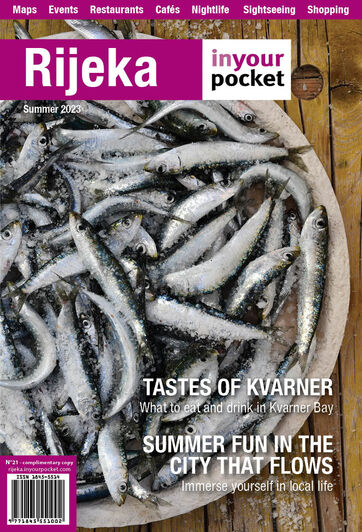Local food & dishes
Let’s start with the islands. The islands of the Kvarner region, especially Cres and Pag, are known in Croatia for excellent lamb, cheeses and medicinal herbs. The first two are dependent on the latter. It is said that the fine flavour of the island lamb is thanks comes from the animals’ pasture on the island hillsides, herbs laced with salt from the wind. Cres and Pag have a number of great eateries where you can enjoy locally-reared lamb – see our Restaurants section. Bear in mind that lamb is naturally at its best in the springtime.
This environment is also the reason why the islanders produce excellent sheep’s milk cheese. Pag island in particular has a long tradition of producing cheese and there are a few good larger manufacturers on the island. A notable one is Gligora – you can call into their factory at Kolan in the central part of the island and taste some of their products.
As well as being a favourite foodstuff of sheep and goats, the benefits of herbs for humans are well-known. One of our favourite things about Croatia’s coast is how lush its vegetation is, and the air is redolent of herbs and pine. For this reason, ever since the 19th century people have been sent on doctor’s orders to the Kvarner coast to recover from illness and allergies. You can buy the distilled benefits of wild herbs in the form of essential oils, balms and strong spirits which have deep roots in folk medicine. Myrtle, bay, strawberry tree, sage and lavender... You can find out more about these herbs by visiting the Garden of Fine Scents at Mali Lošinj town (Ulica Braće Vidulića 68).
Still on the islands, we can’t talk about Kvarner cuisine without mentioning šurlice, a speciality from the island of Krk which you’ll find throughout the region. This is a type of pasta made by wrapping the dough around a knitting needle. Hand-made pasta with a rich sauce is always a pleasure, and there are many different sauces to choose from, though we’d say goulash is probably a classic.
On the island of Rab, you’ll probably spot rapska torta (Rab cake). This is a centuries-old recipe that was a favourite of wealthy families during the Venetian Republic. Often shaped like a spiral, a marzipan-like mix of almonds, eggs, lemon and orange peel and Maraschino liqueur is encased in delicate pastry. It’s usually baked at weddings and other celebrations, and since it keeps for about two months it’s sold beautifully-packed as a souvenir.
Most island villages in the summer months have festivals during which you can sample local delicacies and enjoy music and dancing with the locals. This is a great opportunity to find out more about the local culture, so we definitely recommend you check the festivals out.
In the springtime, a brilliant treat is asparagus picked in the wild. Wild asparagus is slimmer than the cultivated variety and has a stronger, slightly bitter taste. It’s great in risottos and pasta, frittatas, soups and salads. Spring is also the time many love to eat wild garlic leaves, which are fabulous in salads or lightly cooked with potato. Sadly though there have been recent cases of poisoning where even knowledgeable foragers have mistaken other kinds of leaves for wild garlic. Just a few such interlopers can be enough to cause fatal poisoning, so we’ll leave it up to you whether to risk it.
On a more cheerful note, come early summer it’s time for delicious cherries. The town of Lovran is famous for its large, sweet cherries (trešnje), so be sure to pick up a kilo or three. Lovran is also famous for excellent-quality sweet chestnuts (maruni), and come autumn time you’ll find chestnut puree in cake shops (slastičarnice), while chestnut desserts adorn many a restaurant menu.
Also for the sweet-toothed, Crikvenica town is famous for a special cake, Frankopan torta, made with apricots or peaches, almonds, raisins, pastry, sweet spices and topped with whipped cream. With such ingredients it was clearly a cake for rich families, and indeed it’s named after the Frankopan nobles. The recipe was among those in one of the first cookery books in central Europe, written by Anna Maria, Princess of Eggenberg, and published in 1686.
Finally, if you get the chance to sample real Kvarner scampi do give them a try. Specimens which are as large as they should be are not easy to find these days, so they carry a hefty price tag, but it’s a real delight.
Before we head inland, we ought to mention nearby Istria, which is also famous for asparagus, as well as local truffles, and an indigenous type of cattle called boškarin. If you have time, we highly recommend you explore inland Istria. Its hilltop towns and villages are reminiscent of Tuscany and Provence, and you’re sure to encounter wonderful food and wine on your travels.
Finally, the uplands that frame Rijeka are famous for game, wild mushrooms and berries. At the very least we recommend that on your way to or from the coast you turn off the motorway at any village or town. There you're sure to find a restaurant where you can stop for a delicious blueberry strudel. Even better, take a trip up Mount Učka right from Opatija, or head into the Gorski kotar highlands (where you'll see idyllic Alpine-style scenery and architecture). You’ll find hearty mountain food that will sate the most voracious appetites.
Refine your search
Choose Categories
Food Markets
Submit




